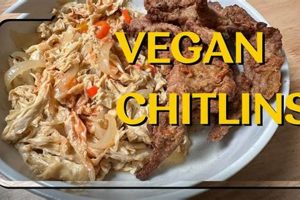Flatbreads, a staple in many cuisines, can be crafted without animal products. These variations use plant-based ingredients like wheat flour, corn flour, or alternative flours, water, and oil. For example, a common recipe includes a mixture of flour, water, and olive oil, resulting in a flexible and versatile wrap.
The significance of these plant-based flatbreads lies in their accessibility for individuals adhering to specific dietary choices, such as veganism. Benefits range from ethical considerations regarding animal welfare to potential health advantages associated with plant-based diets. Historically, similar flatbreads have existed across cultures, demonstrating that grain-based wraps can be made without animal-derived fats or ingredients.
The following sections will delve into the different types of plant-based wraps, their nutritional profiles, culinary uses, and tips for preparing them at home. Further analysis will explore sourcing sustainable ingredients and the role of these flatbreads in various dietary practices.
Guidance for Selecting Plant-Based Flatbreads
This section provides essential guidelines for selecting and utilizing plant-based flatbreads effectively. Understanding these considerations can enhance the culinary experience and ensure dietary suitability.
Tip 1: Ingredient Examination: Scrutinize the ingredient list. Ensure the product is devoid of animal-derived components, such as lard or whey. Common plant-based ingredients include wheat flour, corn flour, water, oil (e.g., olive, canola), and salt.
Tip 2: Flour Type Consideration: Different flours offer varying textures and nutritional profiles. Whole wheat versions provide increased fiber, while corn versions are naturally gluten-free. Experiment with different flour combinations for desired taste and texture.
Tip 3: Sodium Content Assessment: Be mindful of sodium levels, as some commercially produced flatbreads may contain significant amounts. Opt for low-sodium varieties or prepare flatbreads at home to control sodium content.
Tip 4: Storage Optimization: Proper storage extends shelf life. Store unopened packages in a cool, dry place. Once opened, reseal tightly or refrigerate to prevent drying or spoilage.
Tip 5: Warming Technique: Warming enhances pliability and flavor. Heat flatbreads in a dry skillet, microwave (covered), or oven for a few seconds until softened.
Tip 6: Versatile Application: Plant-based flatbreads offer versatility in culinary applications. Utilize them for wraps, tacos, quesadillas, pizzas, or as a side for dips and spreads.
Tip 7: Homemade Preparation: Consider preparing flatbreads from scratch for complete control over ingredients and customization to specific dietary needs. Numerous recipes are available online and in cookbooks.
Adhering to these guidelines facilitates informed decisions regarding plant-based flatbread selection and utilization. These choices contribute to a satisfactory culinary experience and alignment with dietary requirements.
The subsequent section will address recipes featuring plant-based flatbreads, providing practical examples of their application in diverse culinary creations.
1. Ingredients
The constituent components of flatbreads determine their suitability for specific dietary needs, including veganism. The selection of ingredients impacts the final product’s texture, flavor, and nutritional profile. The subsequent discussion explores key facets related to the composition of plant-based flatbreads.
- Flour Base
The primary ingredient is typically flour, which can be derived from various sources. Wheat flour is a common choice, providing a pliable texture. Corn flour, particularly masa harina, is used for a different texture and flavor profile often found in specific regional cuisines. Alternative flours, such as those made from oats, rice, or legumes, offer gluten-free options and distinct nutritional properties. The selection of flour dictates the final texture and nutritional content of the flatbread.
- Liquid Component
Water is the most common liquid ingredient, serving as a binder and facilitating gluten development in wheat-based recipes. Other liquids, such as plant-based milk (e.g., almond, soy, oat), can be incorporated to enhance flavor or add subtle sweetness. The type and quantity of liquid influence the dough’s consistency and the flatbread’s final moisture content.
- Fat Content
Fats contribute to the texture and pliability of the flatbread. Plant-based oils, such as olive oil, canola oil, or coconut oil, are commonly used. The addition of fat helps to create a softer, more flexible product. The choice of oil affects the flavor profile, with olive oil imparting a distinct taste compared to neutral oils like canola.
- Leavening Agents (Optional)
While many flatbread recipes are unleavened, some may incorporate leavening agents such as baking powder or baking soda. These agents create a slight rise, resulting in a softer, more airy texture. The inclusion of a leavening agent alters the final texture, producing a product that is less dense than traditional unleavened flatbreads.
These elements collectively define the characteristics of plant-based flatbreads. Variations in ingredient ratios and types allow for customization to meet specific preferences and dietary requirements. Understanding the role of each component is essential for successful preparation and modification of recipes, ensuring adherence to a plant-based dietary framework.
2. Preparation
The preparation of plant-based flatbreads directly influences their texture, flavor, and structural integrity. Inadequate preparation, such as insufficient kneading or incorrect hydration of the dough, results in a brittle or tough final product. Conversely, proper preparation techniques yield a pliable and palatable flatbread suitable for various culinary applications. For example, overworking a wheat-based dough can lead to excessive gluten development, causing a dense and chewy texture, whereas under-kneading results in a crumbly flatbread that easily tears. The careful selection of preparation methods is, therefore, paramount in achieving a desirable outcome.
Specific preparation steps, such as the resting period of the dough, significantly impact its elasticity and workability. Allowing the dough to rest allows the gluten strands to relax, resulting in a more easily manageable and extensible dough. Temperature control during both dough preparation and cooking is also crucial. Excessively high cooking temperatures can lead to rapid dehydration, resulting in a dry and inflexible flatbread. A moderate cooking temperature ensures even heat distribution and prevents premature browning. The consistent execution of precise preparation steps, therefore, determines the success of the final product.
Ultimately, meticulous attention to the details of preparation is critical for producing high-quality plant-based flatbreads. These details encompass ingredient ratios, mixing techniques, resting times, and cooking temperatures. Mastery of these elements leads to a consistently superior product that meets the desired textural and flavor profiles, rendering it suitable for a wide range of culinary uses. The inherent challenges in preparing this food underscore the importance of understanding and implementing proper techniques for achieving optimal results.
3. Versatility
The inherent adaptability of plant-based flatbreads contributes significantly to their culinary appeal. Their neutral flavor profile enables them to serve as a foundation for a wide array of ingredients and dishes, accommodating diverse palates and dietary requirements. This versatility stems from their capacity to function as wraps, tacos, quesadillas, pizzas, or simply as an accompaniment to various dips and spreads. The lack of strong flavors allows the other components of a dish to take precedence. The absence of animal products further expands their suitability for individuals adhering to vegan or vegetarian diets, providing a plant-based alternative to conventional flatbreads containing lard or other animal-derived fats. For example, a corn-based flatbread can be paired with seasoned black beans, avocado, and salsa for a plant-based taco, or it can be used as a base for a pizza topped with vegan cheese and vegetables.
The adaptability of these flatbreads extends beyond meal composition to preparation methods. They can be grilled, baked, pan-fried, or even microwaved, offering flexibility in cooking techniques. This adaptability is particularly beneficial for home cooks seeking convenience and efficiency. Furthermore, plant-based flatbreads can be readily adapted to incorporate different flours and spices, enhancing their nutritional value and flavor complexity. For instance, adding flax seeds or chia seeds to the dough increases fiber content, while incorporating spices like cumin or chili powder adds depth of flavor. This customization allows for the creation of flatbreads tailored to specific nutritional goals and taste preferences.
In summary, the versatility of plant-based flatbreads is a defining characteristic that significantly enhances their value in the culinary landscape. Their neutral flavor, adaptability to various cooking methods, and capacity for customization make them a staple for individuals seeking plant-based alternatives. While challenges may arise in sourcing high-quality ingredients or mastering specific preparation techniques, the benefits of this adaptability far outweigh the difficulties. The growing demand for versatile, plant-based options underscores the importance of understanding and maximizing the culinary potential of these flatbreads.
4. Nutrition
The nutritional profile of plant-based flatbreads is directly influenced by their constituent ingredients. Variations in flour type, added fats, and supplemental components (e.g., seeds, spices) result in significant differences in macronutrient and micronutrient content. For example, a flatbread made with whole wheat flour offers a higher fiber content compared to one made with refined white flour, contributing to improved digestive health and satiety. The inclusion of plant-based oils, such as olive oil, provides a source of monounsaturated fats, considered beneficial for cardiovascular health. The selection of ingredients, therefore, determines the overall nutritional value of the flatbread and its potential impact on health outcomes.
The practical significance of understanding the nutritional composition of plant-based flatbreads lies in the ability to make informed dietary choices. Individuals seeking to increase their fiber intake may opt for whole-grain varieties, while those with gluten sensitivities can select flatbreads made from alternative flours like rice or corn. Furthermore, individuals monitoring their sodium intake should scrutinize product labels, as commercially produced flatbreads may contain elevated sodium levels. By carefully examining the ingredient list and nutritional information, consumers can select flatbreads that align with their specific dietary needs and health goals. Homemade flatbreads offer further control over ingredient selection, allowing for the incorporation of nutrient-dense additions like flax seeds, chia seeds, or vegetables. For example, individuals following a low-carbohydrate diet might experiment with flatbreads made from almond flour or coconut flour, while those seeking to increase their iron intake could incorporate iron-rich flours like teff.
In conclusion, the nutritional profile of plant-based flatbreads is a multifaceted aspect, dependent on the selection and proportion of ingredients. Recognizing the connection between ingredients and nutritional content empowers consumers to make informed choices aligned with their dietary requirements and health objectives. While challenges may arise in accurately assessing the nutritional value of commercially produced flatbreads due to variations in manufacturing processes, the principles of ingredient-based analysis remain fundamental. The growing awareness of the health implications of dietary choices underscores the importance of understanding the nutritional aspects of plant-based flatbreads and incorporating this knowledge into food selection practices.
5. Accessibility
Accessibility, in the context of plant-based flatbreads, encompasses both the availability of these products in various markets and the economic feasibility for consumers across diverse socioeconomic strata. The widespread availability of these flatbreads is a primary driver of their adoption and integration into dietary patterns. Conversely, limited accessibility, whether due to geographic constraints or high costs, restricts their consumption and hinders their potential health benefits for specific populations. For example, in regions with limited access to grocery stores or a preponderance of convenience stores offering only conventional flatbreads, access to plant-based options is significantly diminished.
The economic aspect of accessibility is equally important. Plant-based flatbreads, particularly those made with specialty flours or organic ingredients, may be priced higher than conventional alternatives. This cost differential can disproportionately affect low-income households, limiting their access to nutritionally superior options. Furthermore, the infrastructure necessary to produce and distribute these flatbreads, including specialized equipment and transportation networks, influences their overall accessibility and affordability. Initiatives aimed at reducing the cost of plant-based ingredients and improving distribution networks are crucial for enhancing the accessibility of these flatbreads to a wider range of consumers.
In conclusion, the accessibility of plant-based flatbreads is a multifaceted issue influenced by factors ranging from market availability to economic feasibility. Overcoming these challenges requires a concerted effort from producers, distributors, and policymakers to ensure that these products are both readily available and economically accessible to individuals across all socioeconomic levels. Failure to address these issues perpetuates disparities in dietary access and limits the potential benefits of plant-based diets for vulnerable populations.
Frequently Asked Questions
The following section addresses common inquiries regarding flatbreads made without animal products, providing clarity on their composition, preparation, and suitability for various dietary needs.
Question 1: What distinguishes flatbreads made without animal products from conventional ones?
The primary distinction lies in the absence of animal-derived ingredients. Conventional flatbreads often contain lard or other animal fats, whereas plant-based alternatives utilize vegetable oils or remain fat-free.
Question 2: What are the typical ingredients in plant-based flatbreads?
Common ingredients include wheat flour, corn flour (masa harina), water, vegetable oil (e.g., olive oil, canola oil), and salt. Alternative flours, such as rice flour or almond flour, are also used for gluten-free variations.
Question 3: Can flatbreads made without animal products be used in the same way as conventional ones?
Yes, plant-based flatbreads are versatile and can be used interchangeably with conventional flatbreads in wraps, tacos, quesadillas, pizzas, and as accompaniments to dips and spreads.
Question 4: Are plant-based flatbreads nutritionally comparable to conventional flatbreads?
The nutritional profile depends on the ingredients used. Whole-grain plant-based flatbreads often offer higher fiber content than refined-grain conventional options. The fat content varies depending on the type and amount of oil used.
Question 5: Where can plant-based flatbreads be purchased?
Plant-based flatbreads are typically available in major grocery stores, health food stores, and online retailers. Availability may vary depending on geographic location and store selection.
Question 6: Is it possible to prepare flatbreads made without animal products at home?
Yes, numerous recipes are available for preparing plant-based flatbreads at home. Homemade preparation allows for complete control over ingredients and customization to specific dietary needs.
In summary, flatbreads made without animal products offer a versatile and accessible plant-based alternative to conventional flatbreads. The choice of ingredients influences their nutritional profile, and homemade preparation allows for customization and control.
The subsequent section will offer recipes featuring plant-based flatbreads, providing practical examples of their application in diverse culinary creations.
Conclusion
This exploration of vegan tortillas has addressed their composition, preparation, nutritional aspects, versatility, and accessibility. The absence of animal products defines this food category, with plant-based ingredients serving as the foundation for diverse culinary applications. Understanding the nuances of ingredient selection and preparation methods is essential for both consumers and producers seeking to maximize the nutritional benefits and culinary potential of these flatbreads.
Continued research into innovative plant-based ingredients and sustainable production practices remains critical for enhancing the accessibility and affordability of vegan tortillas. Further investigation into their long-term health impacts will contribute to a more comprehensive understanding of their role in plant-based diets. The evolving landscape of food technology and consumer preferences suggests a growing demand for these plant-based staples, underscoring the need for continued innovation and refinement within this sector.







